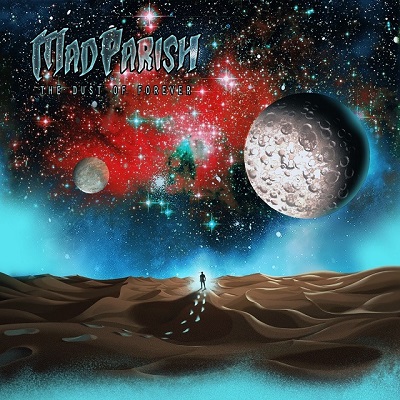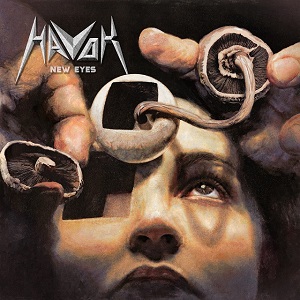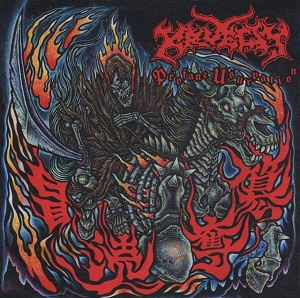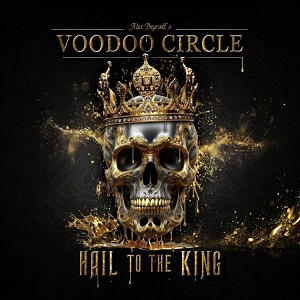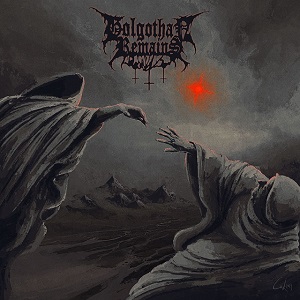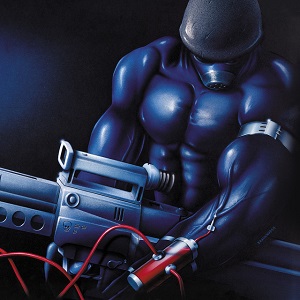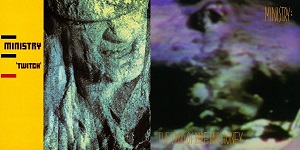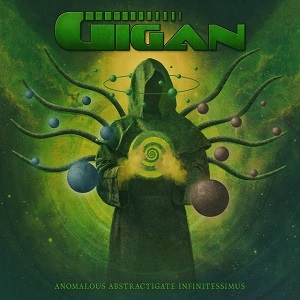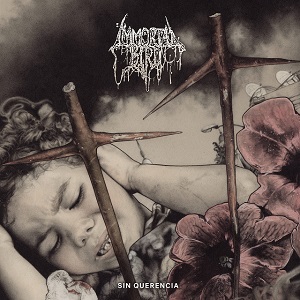WITH THE DEAD – “Each Step Is One Step Closer To Death”
October 3, 2017, 7 years ago

“The ambition of the first one was to make it as heavy as we possibly could – within the confines of what we do obviously. We wanted it to be as soul destroying as possible,” says With The Dead vocalist Lee Dorrian, looking back on his band’s self-titled debut album from 2015. Two years later and the follow-up has arrived; a heaping platter of doom and gloom titled Love From With The Dead.
“The only place to go would be even more low,” acknowledges Dorrian. “In my personal life, things haven’t been too great; they’re okay now, but I’ve gone through a bit of a shit time these past few years. It’s all come to a head really in the last year and a half. All those things that you go through… if you’re in a doom band, you’ve got to get it out of your system through the music. It’s not 1990 anymore, so it’s very easy to make so called ‘heavy music’ and records that sound – I hate to use the word – crushing. There’s a lot of things you can do in the studio – triggers on the drums, down-tune your guitars. At the end of the day, that’s just the sound. With us, the physical expression and raw emotion that comes out is equally as important as the sound. Hopefully that separates us from the bands who just play an open E chord for half an hour. Personally speaking, I don’t really listen to music this heavy on a day to day basis. If I did, the way I perceive it would be a lot different. Having grown up with this kind of music, it’s there inside you and whenever it needs to come out, it’ll come out. Hopefully, with this album – we’ve gone one step further than the first – and made it even more bleak.”
Before exposing the unfortunate experiences that plagued Lee’s personal life and inspired the songs on Love From With The Dead, the lineup change is addressed. Guitarist Tim Bagshaw (Electric Wizard) remains, yet drummer Mark Greening has been replaced by Alex Thomas (Bolt Thrower), with bassist Leo Smee (Cathedral) also joining the band. That being said, Alex and Leo have been members of With The Dead for a while now as they played all of the With The Dead live shows in 2016. Did the new lineup make the studio experience more energetic? “It did. It made it more urgent sounding I think. The album was recorded in two sessions, and they’re a year apart from each other,” reveals Dorrian. “Basically, it became quite apparent that we couldn’t work with Mark (Greening, drummer); it was just too difficult and causing too many problems. I’m not going to go into detail on that cause I don’t want to sit here and slag somebody off, that’s not what I’m about.”

“After Cathedral, I didn’t think I’d be in another fucking band again; let alone a band that’s recording an album and then going out touring. But the (debut) album got a good response and there was a demand for us to play festivals in Europe, and also go to Japan. I thought, if the demand’s there, why not do it? It’d be stupid not to. So, we agreed to do all these shows whilst Mark (Greening, drummer) was still in the band. Then it became apparent that we couldn’t work with him anymore. We were in a situation where it was only me and Tim (Bagshaw, guitarist), and a load of fucking gigs to do. Of course, we had to find a bass player anyway (Tim played both guitar and bass on the debut album). I just thought Leo (Smee) was a no-brainer really cause although I don’t see him a lot, he’s still somebody that’ll be a friend of mine until the day I die. He’s just one of them people, that if you don’t see ‘em for a year or so, I still know he’s going to be a good mate. We went through a lot together in Cathedral, and he’s a shit-hot bass player.”
“But finding a drummer that can play this style is not easy, especially in The UK. I kind of hit a wall with that. We were thinking about getting all kinds of people from America to come over and audition; but it seemed a bit too long-winded really. I mentioned it to Leo, and he said, ‘you should try Alex.’ I’d met him a couple times before, but not in any great detail. So, we booked a few nights rehearsal, cause Tim lives in New Jersey. To do anything, he has to fly over. So, he flew over, we tried Alex and Leo, and it just instantly clicked. It was better than it was before. There was no stress involved, which up until that point, all we’d fucking had was stress! When you get to this point in your life, having been in so many bands before, the last thing you want to do – especially if you didn’t plan to be in a band again – is to go into one that’s going to be fucking stressful again. There’s no way, I just can’t be dealing with it. So, it became apparent that Leo and Alex were going to work perfectly.”
“By the end of the first night, we had the set rehearsed twice and it was the best it ever sounded. But we had these three extra nights that had been booked. So, I suggested working on new material; which is totally what I wasn’t expecting at all. I wasn’t expecting to write anything until later in the year. We came up with five songs, four of which are the last four on the album. ‘Cocaine Phantoms’, ‘Watching The Ward Go By’, ‘Anemia’ and ‘CV1’ were all written in three nights, and recorded two days later, just before Tim flew home. We weren’t expecting to do any of that! Luckily, the studio was free, so we went in and laid these tracks down whilst they still had an air of spontaneity to them. In the end, we had enough songs to release as an album, but we sat on the tracks, got the shows out of the way, and reassessed them at the end of the year. We thought we needed two or three more songs to add a bit of variation to the overall vibe of the record. At the end of last year, 2016, Tim came up with the riffs for the first three songs on the album. We went in the studio in January, had one night’s rehearsal, and recorded them all the next day. That was it.”

Although the artwork adorning Love From With The Dead might appear to be a realistic looking Halloween prop, it’s actually a mummified human body. “It’s by a photographer in Italy named Carlo Vannini; I like his stuff. I’d been casually thinking about what to do for a cover? I had various ideas… just like the music, you don’t want to spend too much time working on some masterpiece of art. The same way you don’t want to overanalyze the music you’re writing and lose the vibe. I wanted the artwork to be kind of the same. I was just looking through some pictures in books that I have and that picture stood out to me; especially the card that he’s holding. I thought that would be cool to have the title there; as opposed to some stupid font plastered all over the front. It just seemed to fit.”
Delving into the doom, “Watching The Ward Go By” appears to be written from the point of view of someone laid up in a hospital bed; they don’t get to watch the world go by, so they watch the hospital ward go by. “That’s exactly it. That was me. About four months ago I was in hospital for two weeks. That was more of an improvisation, that track. It was recorded in January of last year, but I didn’t have words for it. These past couple years, there’s been a lot of stress, anxiety, and shit going on; I don’t want to go into too much detail about it. But, my physical health suffered and I got admitted into hospital cause I lost a lot of blood, and various other things. I ended up stuck in a ward for two weeks having blood transfusions, and basically recuperating. But I was on a ward that was – put it this way, I was the youngest person there at 49. Everyone else was at least 89 to 90 years old and suffering from dementia. I was in the middle of this ward for two weeks – night and day – surrounded by dementia patients; it was quite an experience. All the samples you hear in the background of that song, I recorded while I was in there. That old cliché – what doesn’t kill us… I got through it okay. It made me rethink a lot of things whilst I had the time to. When I’m out doing normal stuff, I’ve never got time to do anything except work really. It made me think about a lot of things really.”

“CV1” is 17-and-a-half minutes long. “That’s just how Tim wrote it. I don’t think there was any drawn-out plan for it to be that long, it’s just the way it happened.” Described as “a mournful lament to Dorrian’s home town of Coventry,” Lee elaborates upon his sadness for those outside of England who’ve never been to Coventry. “For those of you who don’t know, in the second World War, Coventry was completely annihilated by Nazi Germany; it was destroyed. The whole city was burnt to the ground pretty much. Up to the day that happened, it was a beautiful town. It was essentially a medieval town like Stratford Upon Avon, or Warwick, with cobbled streets – very picturesque. One day it’s like that, the next day it’s just ash. It’s still a city that’s never fully recovered from that, and understandably so. After the war and the city rebuilt itself in the late ‘40s, the city was probably the most modern city in the world. Architecturally, it was quite stunning when it was first rebuilt. Also, around that time in the ‘50s and ‘60s, Coventry had a real big boom via the motor industry. Most of The UK’s car manufacturing plants were based in Coventry. It was almost like the Detroit of The UK. It was a real booming time until the mid to late ‘70s when the whole of Britain started to suffer. Maggie Thatcher came into power and things started going from bad to worse.”
“But all during that time, since I was a little kid, even though the city was destroyed and rebuilt, the way it was rebuilt, I used to really like it. Obviously, it’s the place I grew up, I used to know the streets inside out. When you’re in gangs at (age) 13, 14, you know every little nook and cranny of every alleyway. It’s the place where your heart belongs really. And to see the way the city’s been treated over the years, it rips your heart out. They’re still destroying whatever survived the blitz – concreting over pebbled streets. Architecturally, they’ve just fucked the place up to no end. They’ll build something that doesn’t fit with the rest of the surroundings, realize four years later that it doesn’t fit, knock it down and put something worse up. They do that all around the city the whole time. They’ve turned it into a dump really, when it used to be so idyllic and pretty. And that kind of reflects a lot of – not necessarily the attitude of the people, cause the people in Coventry are really strong-willed, genuine, and down to earth; more so than a lot of other places. But the city always gets a bad rap. It always gets a negative response from other towns and the media, when it doesn’t deserve it. It should be recognized more for the things it’s achieved than the things it’s lost. In the back of my mind, I always wanted to do a song about Coventry, but there was never a right moment. This just seemed like, this song suited the overall feeling of woe I have when I think about the way the city’s treated. It’s not an attack on the city, it’s the opposite actually. It’s a lot of frustration about the way it’s treated.”
(Photos by: Ester Segarra)

